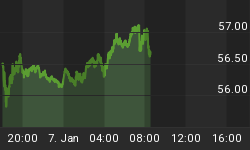Barron's at last weekend's issue has a cover article talking about commodity bubble. Don't get too scared by it. First of all, a cover article like this saying bubble usually means it is not a bubble yet, from contrarian perspective. Secondly, price increase itself doesn't necessarily indicates the status of a bubble, if the fundamental supports it, especially after a long period of very depressing low prices. For example, NASDAQ had a good run of multiple folds for 10 years after 1987 market crash, it was still much lower in 1997 than today's price even after the famous 2000 crash from the internet bubble. Also during those 10 years, NASDAQ has gone through many sector rotations, from computer hardware to software, from telecom to internet. At the end of the day, for commodities, it is always the supply and demand driving the price long term. The commitments of traders (COT) report is important for individual commodities, but more from short term trading perspective due to the nature of speculation, and I also agree some of them have too much hype in them and due for correction, but from a few individual commodity COT reports to predict that the whole commodity sector is in bubble stage, it is premature and has little predictable power.
I think what has been happening in the commodity market since early in the decade is a sector and product rotation among commodities themselves. I am fully aware that it is always dangerous to say this time is different, but we have not seen this type of commodity rotation for a while. But at the same time, it is really not "this time is different", because this somewhat similar rotation happened in 1970s too. In both periods, we see that oil, uranium and energy are leading the charge, then the solid commodities (metals) and soft ones (agricultural products) follow. When one or several of them get overbought, overheated and take a rest with correction, a few others simply take over to lead the charge, so on and so forth. Today when everyone is cheering about wheat and soybeans finally correcting, does anyone notice that rice and corn are actually at all time high?
This commodity boom is actually more dangerous than 1970s when people were more focusing on energy and monetary function of precious metals. Wheat is the common ingredient for almost all foods in the supermarket, rice is everything for people living in Asia. There have been many indications that the agricultural consumption continues to grow each year, and inventories remain at all time low, production remain flat or declining, similar to oil, energy and metal sectors, without even factoring in biofuel. There is shortfall in almost every commodities, no matter solid or soft, black or white. With inventories low and demand high for all agricultural products, with competing acreage among them, the USDA's Prospective Plantings report becomes less meaningful than before. Due to the price drop in soybeans and rise in corns, Farmers will probably change their mind by the time of planting anyway.
When every essential element of our life is going up, such as food, there is really not much anyone can do, including the governments trying to curb inflation, since there is no cheaper substitution hanging around anymore. There are already many reports indicating that about 30 countries in the world are running short of food, more and more governments are blocking any export of agricultural products to ensure their own people get feed first. This is contagious, which will cause more governments to do so, making the food shortage a much bigger problem to solve at the global basis. Same thing on inflation, thanks to the much more global financial market than 1970s, inflation also becomes much more contagious than before.
This commodity rotation will also make people holding any type of commodities profitable, since commodities are taking their turns to go up. As far as people don't chase the high flying ones, use minimum leverage, have patience to sit and wait for the next turn on theirs, in a year or two or even shorter, their time will come.
















